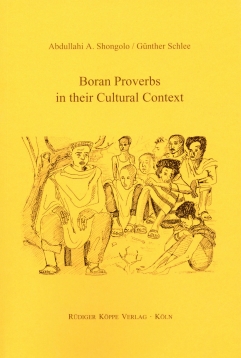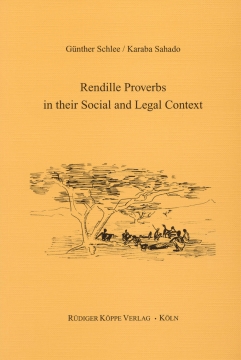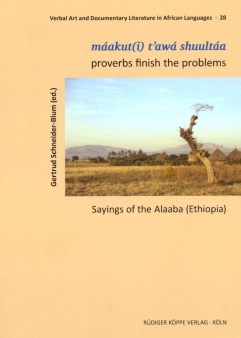


Boran Proverbs in their Cultural Context
Author: Abdullahi A. Shongolo, Günther Schlee. Series edited by: Wilhelm J.G. Möhlig †.
Series: WK Verbal Art and Documentary Literature in African Languages Volume 24
2007139 pp.
8 b/w drawings, index: English-Boran
Text language(s): English
Format: 160 x 240 mm
340 g
Paperback
€ 34.80
Buy 'Boran Proverbs in their Cultural Context' as a downloadable PDF document directly from our online shop »
Order 'Boran Proverbs in their Cultural Context' as print edition »
The Boran are a southern Oromo group which occupies a senior position in Oromo traditional history. Their contact period with the Amhara was shorter than that of other Oromo groups and their dialect has incorporated fewer Amharic loanwords, so it is a relatively “pure” form of Oromo. Their richness in proverbs is enormous, even in comparison to other African peoples who have preserved orality in many spheres of life (the everyday sphere, the jural sphere, the passing on of history) and thus have good use for proverbs to sharpen their arguments, rend savour to their accounts and give everything they say the ring of acceptance by tradition and of legitimacy.
In this publication a collection of 100 proverbs is presented which are analysed, illustrated and contextualised in a way which puts also those not fortunate enough to have Oromo as their mother tongue in a position to understand them and to enjoy their wit. The single proverbs are presented in various steps:
1. the Oromo version as transcribed from spoken Oromo,
2. the morpheme by morpheme representation, giving underlying forms (the grammatical ideas) where in spoken Oromo phonetic assimilations and simplifications have taken place,
3. the morpheme by morpheme translation,
4. the translation in grammatically correct English,
5. additional explanations entitled meaning, use, cultural context etc.,
6. examples for the use of the proverb.
These examples for the use of the proverb take the shape of stories about legal cases which have been brought to the attention of elders who then deal with these cases and underline their positions by quoting the proverb in question.
Some of these stories are criminal stories, others deal with ordinary everyday conflicts like the ones between husband and wife or between the generations. Most of them are fictional. Because of these illustrations this book is also a book of stories. Linguists may use them to study syntax and textual grammar or other aspects of the language which cannot be studied from short fragments of a language.Those interested in culture can learn a lot about Boran life and the attitudes of the Boran about life from them.
Under these links you will find a Grammar of Boraana Oromo and further collections and analyses of African proverbs:
Accompanying material:
- A Grammar of Boraana Oromo (Kenya)
(ISBN 978-3-89645-485-0 ) - Oromo Oral Poetry Seen from Within
(ISBN 978-3-89645-276-4 ) - Rendille Proverbs in their Social and Legal Context
(ISBN 978-3-89645-271-9 )
Cross-reference:
- Búun Saba – Proverbs, Sayings and Maxims in Eastern Tangale
(ISBN 978-3-89645-467-6 ) - Goldgrube – Oromo-Sprichwörter und -Redewendungen
(ISBN 978-3-927620-29-2 ) - Luba-Sprichwörter
(ISBN 978-3-927620-61-2 ) - Mandinka Spoken Art
(ISBN 978-3-927620-63-6 ) - Proverbs Finish the Problems – máakut(i) t’awá shuultáa
(ISBN 978-3-89645-284-9 ) - Tonrelationen in Luba-Sprichwörtern
(ISBN 978-3-927620-62-9 ) - Traditions, Tales and Proverbs of the Bali-Nyonga
(ISBN 978-3-927620-32-2 )
Reviews
Die größte Stärke der vorliegenden Arbeit besteht darin, dass die Einbettung der Sprichwörter in den kulturellen Kontext ausführlich dargelegt wird. Es werden nicht nur Gelegenheiten angeführt, bei denen ein bestimmtes Sprichwort verwendet wird, sondern darüber hinausgehend Geschichten vorgetragen, die die aktuelle Verwendung illustrieren bzw. ihre Entstehung – auch im aitiologischen Sinne – beleuchten. Diese Texte, die in Oromo und Übersetzung angeführt werden, sind so umfangreich, dass man bei vorliegendem Werk von einer Sammlung traditioneller Borana-Geschichten sprechen muss, die unsere Kenntnis von der traditionellen Erzählweise der Oromo wesentlich bereichern.
Rainer Voigt in Zeitschrift für Ethnologie, 135/2010, 350-352
These stories, in addition to material for proverb study, provide rich material for folklorists, linguists, cultural anthropologists, etc.
Peter Unseth in Proverbium, 28/2011, 427-434
| « back | Print version | [top] |
 Books
Books Audio
Audio Biographies
Biographies Series
Series Festschrifts
Festschrifts Journals
Journals